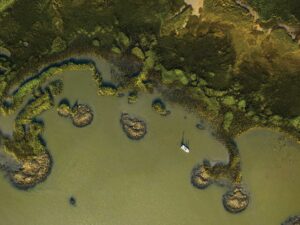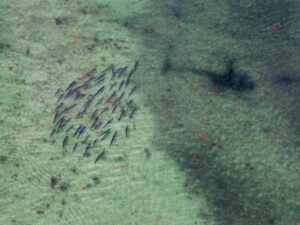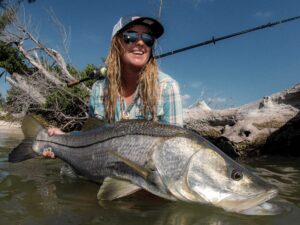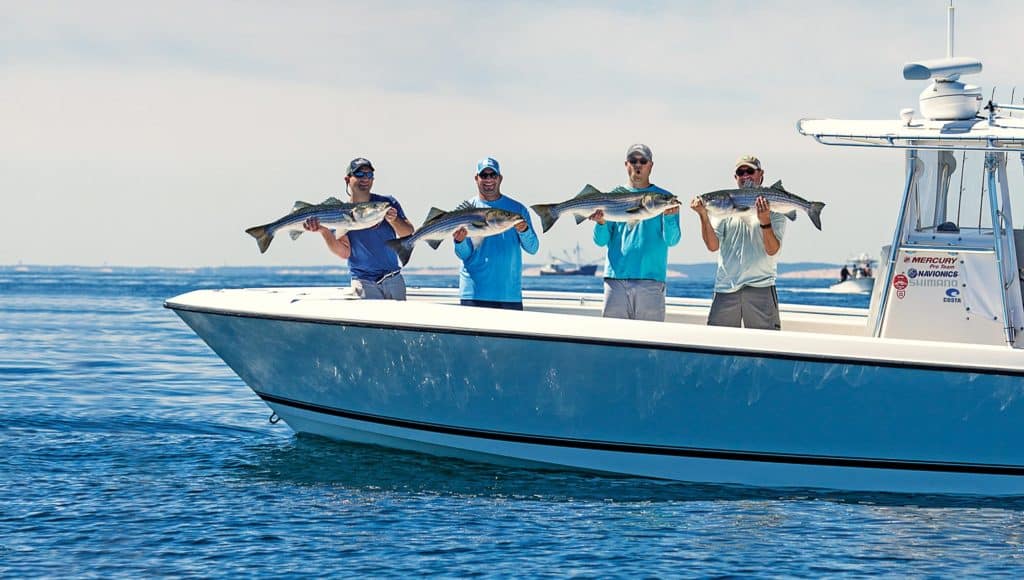
Spring has sprung, and from Maryland to Maine, stripers are on the move. The combination of optimal water temperatures and the northbound migration of bunker is the driving force.
Dedicated bass hounds follow the striper run along the East Coast, intercepting the fish as they return to their main spawning grounds of the Chesapeake Bay, Delaware River and Hudson River, and enter various smaller tributaries and bays from the mid-Atlantic to New England. The most hardcore anglers plan a road trip to chase the [striped bass](Fishing for striped bass in New Jersey.) — from schoolies to 50-pound trophies — as the fish feast on bunker schools from March through early July.
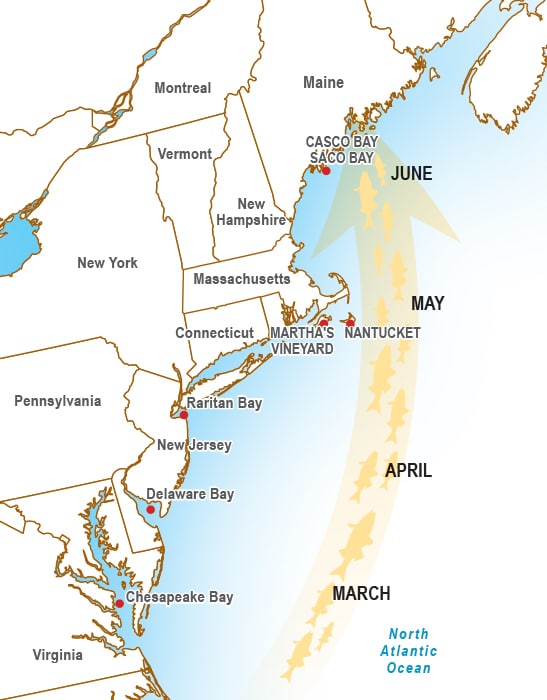
Start Down South
Come spring, striped bass wintering in Virginia and North Carolina waters are primed to make their move north on the trail of migrating bunker schools. In March and April, look no further than Chesapeake Bay and Susquehanna Flats. “Wherever the bunker go, the bass follow,” states Capt. Drew Payne of Big Worm Charters in Chesapeake Beach, Maryland, who regularly works the bay waters from Solomon’s Island to the Bay Bridge. “So finding the bait is the number one priority, even more important than water temperature.”
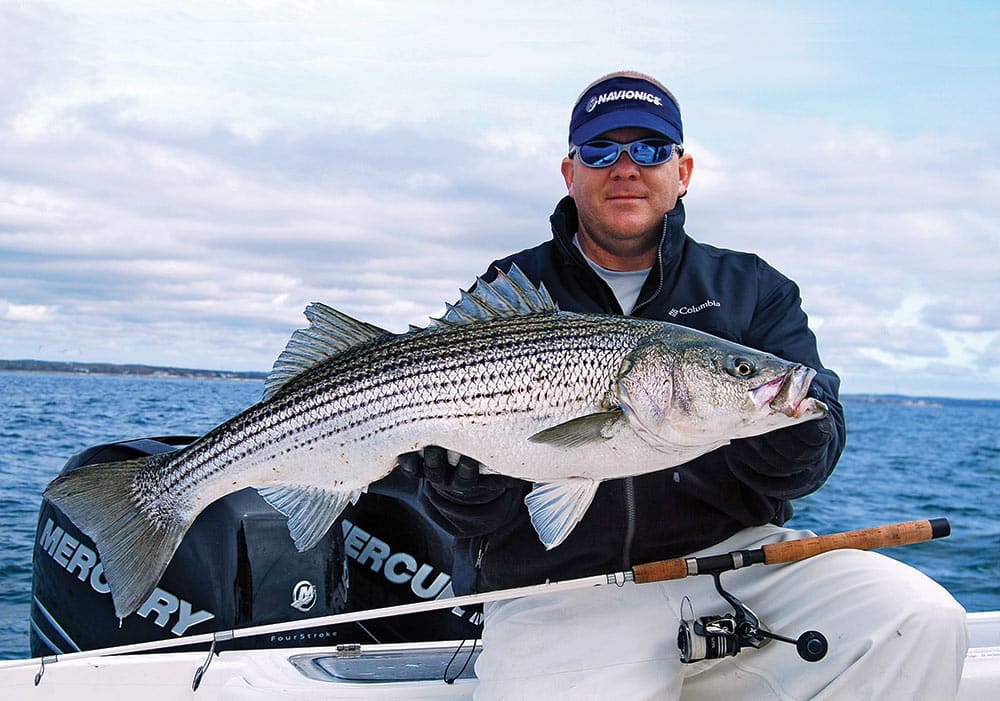
Payne’s top tactic is to pull parachute jigs off his own homemade planer boards built with a 2-by-12 piece of pressure-treated lumber. “The parachute jig mimics the bunker profile, so I run a few 4- to 12-ounce Spankin’ Stripers parachute jigs in white with a purple, black or green head,” says Payne. “You want to troll them at 2 to 3 knots and up in the water column — 10 to 20 feet down, even when fishing depths of 50 to 100 feet in the channel or 30 to 50 feet on the edges.”
His main rig consists of 65-pound braided line, a 25-foot section of 60-pound monofilament leader, and a parachute jig tied with an improved clinch knot. “I don’t use any weight on the planer board or leader; the depth is controlled by the speed of the boat and the weight of the lure,” explains Payne. Other popular Chesapeake-area tactics include Mojo Ball trolling, bucktailing, or live-lining eels around the bridges. Generally, by May 15 the main body of rockfish (as stripers are called south of Delaware) in the bay are long gone, and the fish are heading northward into New Jersey and New York waters.
Metro Midrun
From April through early June, the striper migration hugs the Jersey shore from Delaware Bay to Raritan Bay, then filters out along the coast of Long Island out to “The End” of Montauk, New York. Different methods are implemented in the metro area. Bunker spoons, live bunker, and shad bars are favorites of boating anglers, while surf casters run-and-gun, mimicking bunker, spearing and sand eels with Bomber plugs, Gibbs Pencil Poppers and Ava jigs.
Fast Facts for Success:
Search for water in the 54- to 65-degree range to locate active stripers.
Pinpoint schooling bunker off the beaches and stripers are bound to be nearby.
With live bunker or lures, tailor rigs and tactics for a natural presentation.
In Jersey, live bunker reigns supreme, and “snag ’n’ drop” is the preferred tactic. It entails casting a 10/0 weighted treble hook on a 50-pound leader and pulling it through bunker schools to snag a baitfish and transfer it to a live-lining rod, placing an 8/0 circle hook near the bunker’s dorsal fin or through the nose before sending it back out and leaving the reel in free-spool, waiting for a pickup.
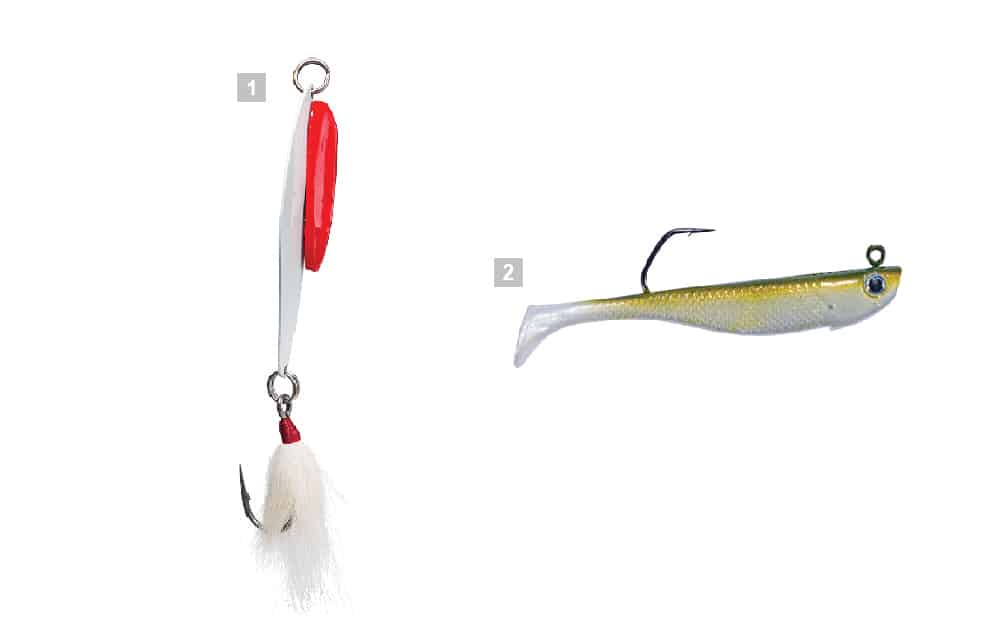
2. An excellent blitz bait, the Hogy Pro Tail Paddle mimics injured baitfish. Salt Water Sportsman
And when bass are aggressive, boiling and crashing bunker schools, a topwater like a Yo-Zuri Hydro Popper or Williamson Surface Pro 180 stickbait cast to the outskirts of the bunker schools garners bone-jarring strikes. A Storm WildEye Shad dropped below the schooling baitfish and jigged vertically to mimic a fleeing bunker also produces. Meanwhile, trollers drag No. 4 Tony Maja spoons on wire-line rods at 2 to 3 knots to target the larger specimens of 30 to 50 pounds.
Read More: Fly-Fishing for Trophy Stripers
Once the stripers make it to Montauk and Long Island shores, surf casters are in their glory, flinging Yo-Zuri Mag Darters, wooden swimmers, and needlefish lures to pluck stripers off the Montauk rocks. Boating anglers bouncing 2- to 6-ounce bucktails tipped with pork rinds through the swashing current of “The Rip” are also handsomely rewarded.
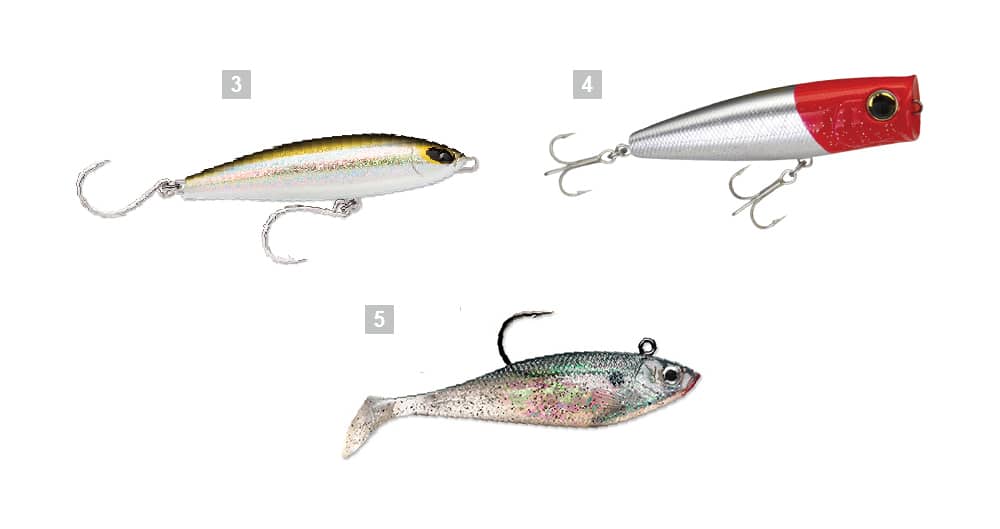
4. Take advantage of surface-feeding stripers off the beaches with topwaters like the Yo-Zuri Hydro Popper.
5. Around bait schools, try a soft swimbait such as the Storm WildEye Shad along the perimeter. Salt Water Sportsman
Northern Finish
The finish line of the spring striper run sets up in June and early July in New England waters from Block Island through Maine’s rocky shores, where anglers vary techniques to accommodate the local flavor, calling into action herring, mackerel and juvenile haddock, the prevalent baitfish in the region.
Read Next: Hot Striped Bass Fishing in New York
“Bass always seem to show up the second week in May and leave by late June, but they sometimes stay until the second week of July,” says Capt. Terry Nugent, who trailers his boat to follow the striper migration through New England.
“The fish come up into Buzzards Bay, through the Cape Cod Canal, then spread out like a shotgun blast in Cape Cod Bay, off Race Point, Nantucket, Martha’s Vineyard and outer Cape Cod.”
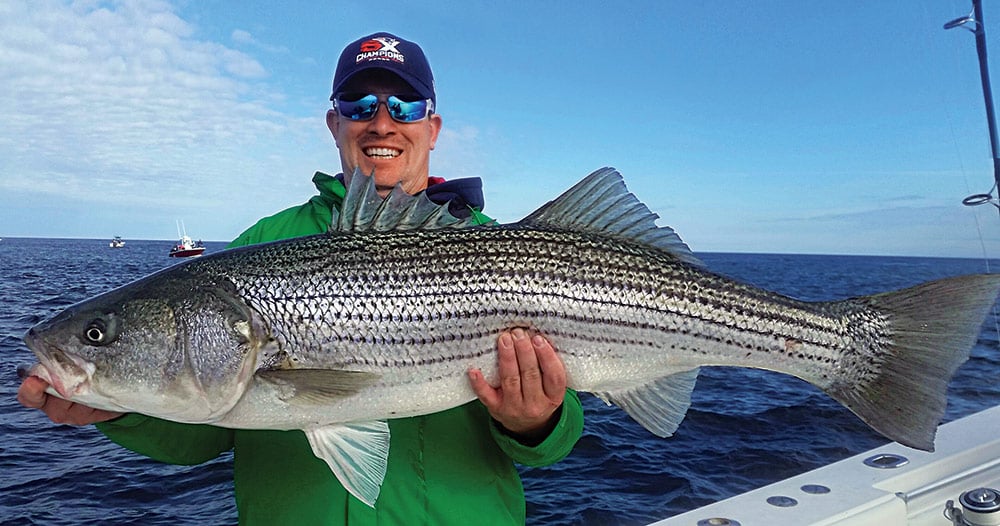
Live-lining mackerel is the most common way to catch bass in the area, but Nugent focuses on working the surface for aggressive strikes. “I use my radar to find birds, then move over to find the blitzes and toss topwaters.” Nugent usually works 2- to 4-ounce Hogy Pro Tails in green or white pearl to imitate mackerel and herring, and runs the soft bait across the surface to get a hit. “Schoolie bass up to 26 inches move in first, but when the larger brethren of 20- to 40-pounders finally show, we switch to 10-inch Hogy Doublewide lures, or Musky Mania Doc plugs, our local worst-kept secret,” says Nugent.
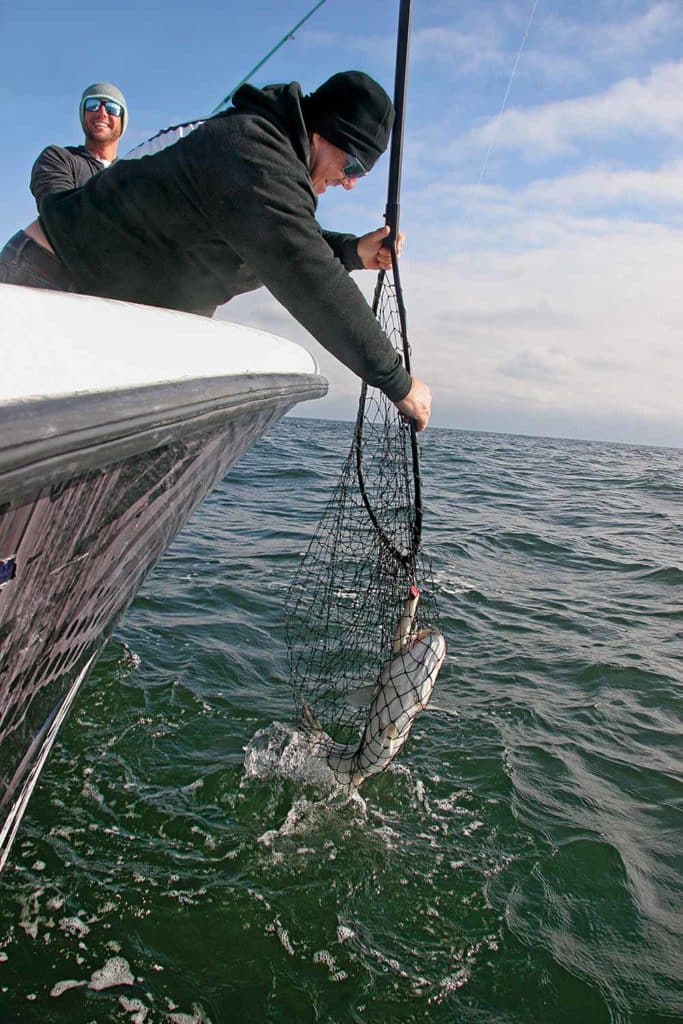
Other popular tactics in the New England area include tube and worm trolling, sandworming, and trolling large wooden swimming plugs. Come late June, the majority of bass schools will have moved up all the way into Maine’s Casco Bay and Saco Bay, where they spend the bulk of the summer.
The pursuit of striped bass can be a simple recreational endeavor for a weekender or a dogged mission for the die-hard striper hound. Wherever you fall within the spectrum, now’s the time get in on the action along the Atlantic Coast to catch the fish of your dreams.
SWS Planner
What: Striped bass
Where: Maryland to Maine
When: March through June
Who: Boating and shorebound anglers.
The following captains know where to find the hot bite:
Cape Cod, Massachusetts
Capt. Terry Nugent
Riptide Charters
riptide@riptidecharters.com
riptidecharters.com
Point Pleasant, New Jersey
Capt. Gene Quigley
Shore Catch Charters
flyfishcharters@aol.com
shorecatch.com
Chesapeake Bay, Maryland
Capt. Drew Payne
Big Worm Charters
410-474-4428
wormcharters.com
SWS Tackle Box
Rods
Spinning: 7-foot rated for 20- to 40-pound; trolling: 51⁄2- to 6-foot rated for 30- to 80-pound line
Reels
Spinning: 5000- to 8000-class; conventional: 16- to 20-poundclass
Lures
Hogy Pro Tail and Doublewide, No. 4 Tony Maja bunker spoons, Spankin’ Stripers parachute jigs, Williamson Surface Pro 180, Yo-Zuri Hydro Popper, Storm WildEye Shad
Line
30- to 65-pound braid, 20- to 60-pound fluoro leader
Other
8/0 to 10/0 Octopus circle hooks, 10/0 weighted bunker snags
FAQ
What state has the biggest striped bass?
The state of Maryland is considered to have the biggest striped bass, with the Chesapeake Bay being a world-renowned fishery for trophy-sized striped bass. Massachusetts and New Jersey also produce large striped bass, but Maryland is often viewed as the top destination for giant striped bass.
What is the lifespan of a striped bass?
Striped bass can live a relatively long life, with a typical lifespan ranging from 20 to 30 years in the wild. However, some exceptional individuals have been recorded living up to 40 years or more under ideal environmental conditions.
What is the biggest striped bass ever caught?
The all-time record for the biggest striped bass ever caught is an 81.88-pound (37.14 kg) monster landed in 1995 by Gregory Myerson in Westbrook, Connecticut. This massive fish measured 53.5 inches (135.9 cm) in length and had a girth of 36 inches (91.4 cm).


